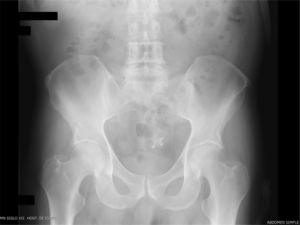A 75-year-old man had a past surgical history of sigmoidectomy with primary anastomosis due to complicated diverticulitis in 2007. The patient accidentally swallowed a 4-tooth dental prosthesis. Gastroscopy performed 12h after the accident did not reveal the foreign body. During the ensuing 10-month follow-up, x-rays were taken until repeated images of the foreign body lodged in the sigmoid colon, with no progression, were observed (fig. 1). Through colonoscopy, the impacted prosthesis was identified inside a sigmoid diverticulum, proximal to the anastomosis. It was gently extracted from the diverticulum by means of a 27-mm loop polypectomy snare. Once the prosthesis was out of the diverticulum, its large size prevented it from being placed inside the overtube. Thus, it was held in place by the loop and with delicate maneuvers was extracted through the anastomosis to the rectum, without damaging the mucosa. Once in the rectum, the endoscopist eased the prosthesis out with his fingers (fig. 2). This is the first report of a case of a dental prosthesis lodged in a diverticulum of the colon.
Foreign body ingestion occurs more frequently in children than in adults. Accidental ingestion in adults is more common in the elderly.1 Most ingested foreign bodies pass through the digestive tract with no complications, but 10 to 20% of cases require endoscopic removal and 1% require surgical treatment.2 Once they pass the pylorus, 20% of long, sharp foreign bodies can cause perforations, generally at the level of the ileocecal valve.3 Perforations caused by foreign body impaction in the lower digestive tract are managed through urgent surgery. Foreign bodies that do not cause perforations can be extracted endoscopically with adequate morbidity and mortality rates.4
Financial disclosureNo financial support was received in relation to this article.
Conflict of interestThe authors declare that there is no conflict of interest.
Please cite this article as: Blanco-Velasco G, Hernández-Mondragón OV, Altamirano-Castañeda ML, Blancas-Valencia JM. Extracción endoscópica exitosa de prótesis dental impactada en divertículo de sigmoides. Revista de Gastroenterología de México. 2019;84:106–107.







